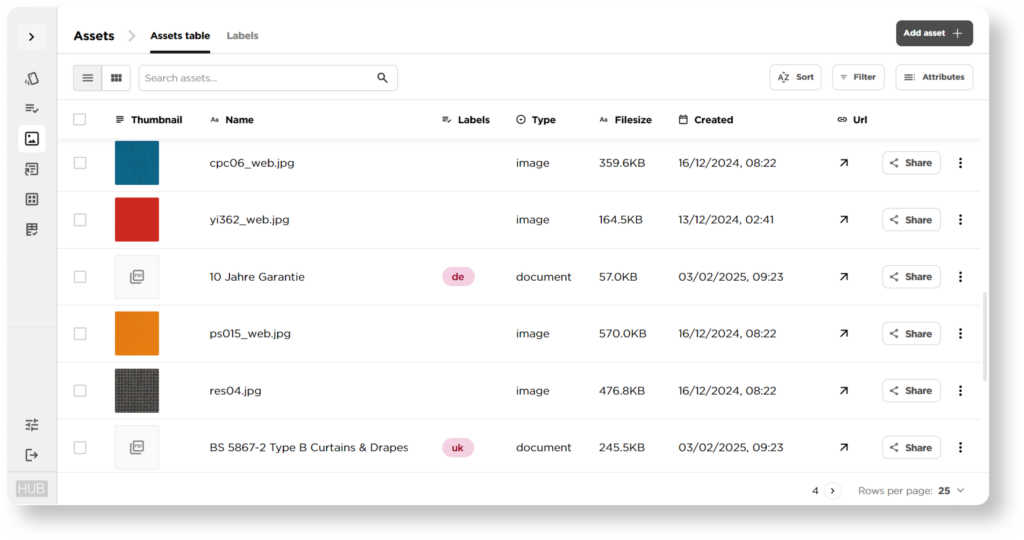
Tsveta Pandzherova
Customer success manager @Stylib
If you’re a supplier or manufacturer of architectural materials, you know visuals and documents win or lose specifications. High-quality images, installation guides, technical sheets – these aren’t just marketing tools, they’re part of the spec decision.
But managing them? That’s the problem.
Images scattered across folders
Old swatches sent to clients
Outdated certificates sitting on shared drives
Multiple teams unsure which version is correct
For suppliers and manufacturers, this isn’t just frustrating – it costs you projects.
This is where a DAM comes in.
What is a DAM?
A Digital Asset Management (DAM) system is specialised software for organising, storing, and retrieving digital assets, the files that bring your products to life:
Images and renders
Videos
Technical sheets and installation guides
Certificates and compliance documents
3D models and BIM files
Unlike a PIM, which manages structured product data (specifications, dimensions, codes), a DAM handles unstructured content. It ensures your visuals and documents are easy to find, always up to date, and consistently used across every channel.

Why suppliers need DAM
- Your marketing and sales teams need the right, approved visuals, no outdated swatches, no missing certifications. A DAM ensures consistency across catalogues, mini-sites, and client proposals.
When you work with distributors, partners, or multiple regions, controlling access is critical. A DAM lets you share assets securely while maintaining brand compliance and legal control.
What does a DAM do?
A strong DAM solution supports four critical functions:
1. Centralise your media library
One searchable system for every image, video, and document – organised by metadata, tags, and product SKUs.
2. Maintain version control
Never send the wrong swatch or outdated technical sheet again. DAM tracks revisions and ensures teams always work with approved versions.
3. Link assets to products
Connect visuals, certificates, and guides directly to the right product SKUs or variants, so assets and product data always match.
Beyond storage: Why DAM matters for your business
A DAM is more than a filing cabinet. It streamlines your workflow, strengthens brand consistency, and protects your assets.
Here’s what it means for suppliers and manufacturers:
Improved efficiency: No more digging through folders – everything is organised and searchable.
Increased productivity: Automation for repetitive tasks (resizing, cropping, organising) frees your team to focus on design and sales.
Better collaboration: Multiple teams can work on the same project without overwriting files.
Legal compliance: Track asset usage and maintain copyright compliance across markets.
Brand consistency: Always deliver the correct visuals and documents to clients, distributors, and partners.
Why it matters in the architectural materials industry
Architects need high-quality visuals and accurate documentation for specifications. If they don’t get it fast, you lose the spec.
A DAM gives you:
Confidence: Your assets are always correct, approved, and secure.
Control: You decide who sees what, and when.
Clarity: Everything in one place, always searchable, always up to date.
Stylib Hub combines DAM with PIM, so your digital assets and product data work together seamlessly -because in this industry, the two go hand in hand.
👉Simplify your product catalogue and asset management today.
Stylib Hub gives every product a consistent, customizable data structure with attributes for technical specs, certifications, dimensions, finishes, and more. Instead of scattered fields or improvised formats, you get a clean, scalable system that supports filtering, validation, and export across any channel or platform.

Datasheets, images, test reports, and certificates all live in one place, connected to the correct product and version. Stylib Hub makes it easy to upload, organise, and update files so you always know what’s current, and you never have to dig through folders or chase the right PDF again.

Not every audience needs the same data. Stylib Hub lets you configure outputs for different destinations, whether it’s a spreadsheet for a distributor, a selection for a client, or a structured feed for your digital tools. One source of truth, multiple outputs, no copy-pasting.
